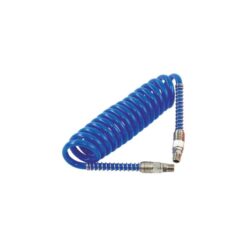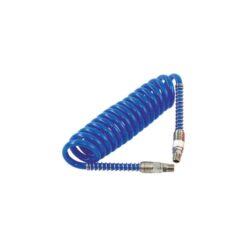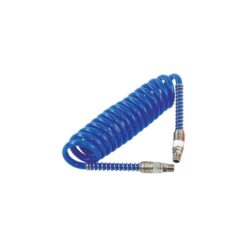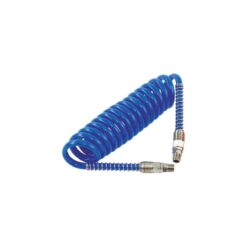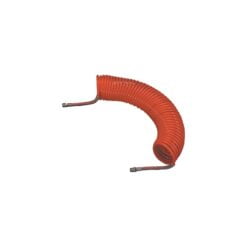Get to know your Air Hoses
As discussed in our resource choosing the right Air Line Hose: A Guide to the different types there are many different types of air hose, so it’s important to know which type you need.
Putting, sizes, brands, lengths and materials aside for a moment, there are two main styles of air hose to choose from: standard or coiled.
A standard air hose is long and lays flat, or is often put on a retractable air hose reel. On the other hand, a coiled air hose (also known as a recoil hose) has a (you guessed it) coiled design which allows it to spring back to its original shape when it’s not in use.
Key Differences between an Air Hose and Coiled Air Hose
So what are the main differences between an air hose and a coiled air hose? Here are a few differences (some more obvious than others).
- Shape.
First and foremost, the most obvious difference is the shape. As mentioned above, an air hose is a straight tube, whereas a coiled air hose has a spring-like shape. - Storage.
Secondly, the coiled air hose has much better retractability. This means clearer workstations as it prevents trip hazards and is therefore easier to store. Although having said that, the retractable air hose reels that we previously mentioned are a great way to rectify that problem with straight air hoses. - Length.
Air hoses are usually much longer than coiled air hoses. In fact, air hoses can range from a few meters to hundreds of meters – it of course all depends what you need it for. In contrast, a coiled air hose is much shorter in its standard form as it’s designed for closer working environments. It can of course be stretched out, but it will offer resistance compared to a flat hose. - Tangles.
Due to its coil design, the recoil air hose provides better tangle resistance. This reduces the chance of the hose becoming kinked or tangled up – especially when in storage. - Flexibility.
Generally speaking a coiled hose is more flexible making it easier to move around. It’s easier to use for “fiddly” tasks where a steady hand is needed. However, there are flexible standard air hoses available which allow you a little more freedom of movement. Likewise, you can buy air hoses with fittings which include swivel ends. Swivel ends allow a much better movement of the hose as they can fully rotate.
Shop Recoil Air Hoses
Polyurethane (PU) Coiled Air Hoses:
Nylon Coiled Air Hose:
Is a coiled air hose the same as a retractable air hose?
No, a coiled air hose and a retractable air hose are not the same, although they share some similarities.
A coiled air hose, as mentioned earlier, has a spring-like coiled shape that allows it to stretch and retract easily. It is typically made from polyurethane or nylon and is designed to be compact and portable.
On the other hand, a retractable air hose, often referred to as a retractable reel or retractable hose reel, consists of a reel mechanism that automatically winds and stores a standard air hose. The reel is usually mounted on a wall, or ceiling with the air hose attached to it. With the help of a spring-loaded mechanism or a motor-driven system, the hose can be easily pulled out to the desired length and retracts back into the reel when released.
The key difference between a coiled air hose and a retractable air hose is the method of retraction. While a coiled air hose relies on its inherent coiled design to retract, a retractable air hose uses a dedicated reel mechanism for automatic winding and storage.
What is a coiled hose typically used for?
They are more suited to an industrial or manufacturing environment. Coiled hoses are often used to help operate machinery in many different industries from food manufacturing to car manufacturing.
They can also be used on construction sites or in carpentry workshops or any other industry where you may need a steady hand to assist you. In addition, some hobbyists prefer using a coiled hose compared to an air hose because of the space saving capacity and ease of use in their home garage.
Polyurethane Vs Nylon Coiled Air Hose, which is better?
Polyurethane and nylon are the two main materials used for coiled air hoses (although you can get others, such as rubber too). So what are the differences between them?
Polyurethane coiled hoses require a tighter bend radius, making them better suited for robotic or pneumatic control machinery. They work well with medium pressure applications and offer excellent resistance from fuels and oils.
Nylon coiled hoses support a higher working pressure and offer a greater resistance to heat and chemicals. Consequently, nylon hoses are better suited to high pressure applications.
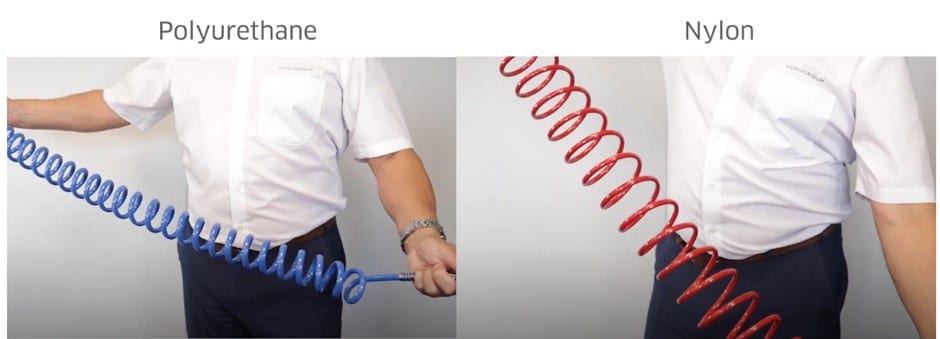
Get Help with Air Hoses
At Metro Sales, we know that finding the right air hose and fittings can be a bit of a minefield. That’s why we have two very useful guides for you:
- Choosing the right Air Line Hose: A Guide to the different types
- The Ultimate Guide to Choosing the right Air Fittings
If you need assistance with anything related to air hoses or compressed air, please get in touch: 01932 348777 or Sales@metrosales.co.uk – We are more than happy to assist and ensure that you get the right tools and fittings for the job you have first time – every time.



